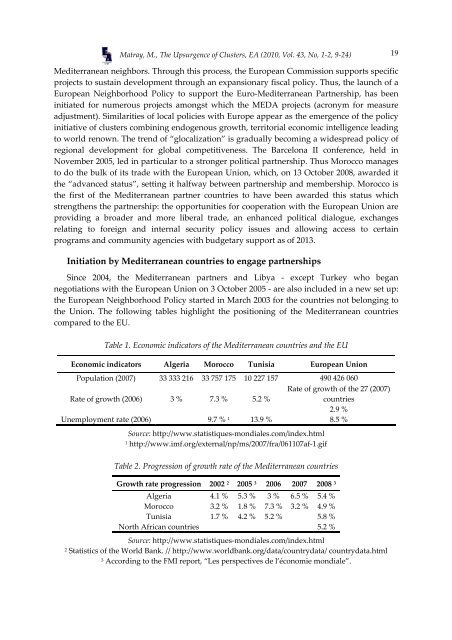Twice a Year Scientific Journal
Twice a Year Scientific Journal
Twice a Year Scientific Journal
Create successful ePaper yourself
Turn your PDF publications into a flip-book with our unique Google optimized e-Paper software.
Matray, M., The Upsurgence of Clusters, EA (2010, Vol. 43, No, 1-2, 9-24) 19<br />
Mediterranean neighbors. Through this process, the European Commission supports specific<br />
projects to sustain development through an expansionary fiscal policy. Thus, the launch of a<br />
European Neighborhood Policy to support the Euro-Mediterranean Partnership, has been<br />
initiated for numerous projects amongst which the MEDA projects (acronym for measure<br />
adjustment). Similarities of local policies with Europe appear as the emergence of the policy<br />
initiative of clusters combining endogenous growth, territorial economic intelligence leading<br />
to world renown. The trend of “glocalization” is gradually becoming a widespread policy of<br />
regional development for global competitiveness. The Barcelona II conference, held in<br />
November 2005, led in particular to a stronger political partnership. Thus Morocco manages<br />
to do the bulk of its trade with the European Union, which, on 13 October 2008, awarded it<br />
the “advanced status”, setting it halfway between partnership and membership. Morocco is<br />
the first of the Mediterranean partner countries to have been awarded this status which<br />
strengthens the partnership: the opportunities for cooperation with the European Union are<br />
providing a broader and more liberal trade, an enhanced political dialogue, exchanges<br />
relating to foreign and internal security policy issues and allowing access to certain<br />
programs and community agencies with budgetary support as of 2013.<br />
Initiation by Mediterranean countries to engage partnerships<br />
Since 2004, the Mediterranean partners and Libya - except Turkey who began<br />
negotiations with the European Union on 3 October 2005 - are also included in a new set up:<br />
the European Neighborhood Policy started in March 2003 for the countries not belonging to<br />
the Union. The following tables highlight the positioning of the Mediterranean countries<br />
compared to the EU.<br />
Table 1. Economic indicators of the Mediterranean countries and the EU<br />
Economic indicators Algeria Morocco Tunisia European Union<br />
Population (2007) 33 333 216 33 757 175 10 227 157 490 426 060<br />
Rate of growth (2006) 3 % 7.3 % 5.2 %<br />
Rate of growth of the 27 (2007)<br />
countries<br />
2.9 %<br />
Unemployment rate (2006) 9.7 % 1 13.9 % 8.5 %<br />
Source: http://www.statistiques-mondiales.com/index.html<br />
1<br />
http://www.imf.org/external/np/ms/2007/fra/061107af-1.gif<br />
Table 2. Progression of growth rate of the Mediterranean countries<br />
Growth rate progression 2002 2 2005 3 2006 2007 2008 3<br />
Algeria 4.1 % 5.3 % 3 % 6.5 % 5.4 %<br />
Morocco 3.2 % 1.8 % 7.3 % 3.2 % 4.9 %<br />
Tunisia 1.7 % 4.2 % 5.2 % 5.8 %<br />
North African countries 5.2 %<br />
Source: http://www.statistiques-mondiales.com/index.html<br />
2<br />
Statistics of the World Bank. // http://www.worldbank.org/data/countrydata/ countrydata.html<br />
3<br />
According to the FMI report, “Les perspectives de l’économie mondiale”.
















